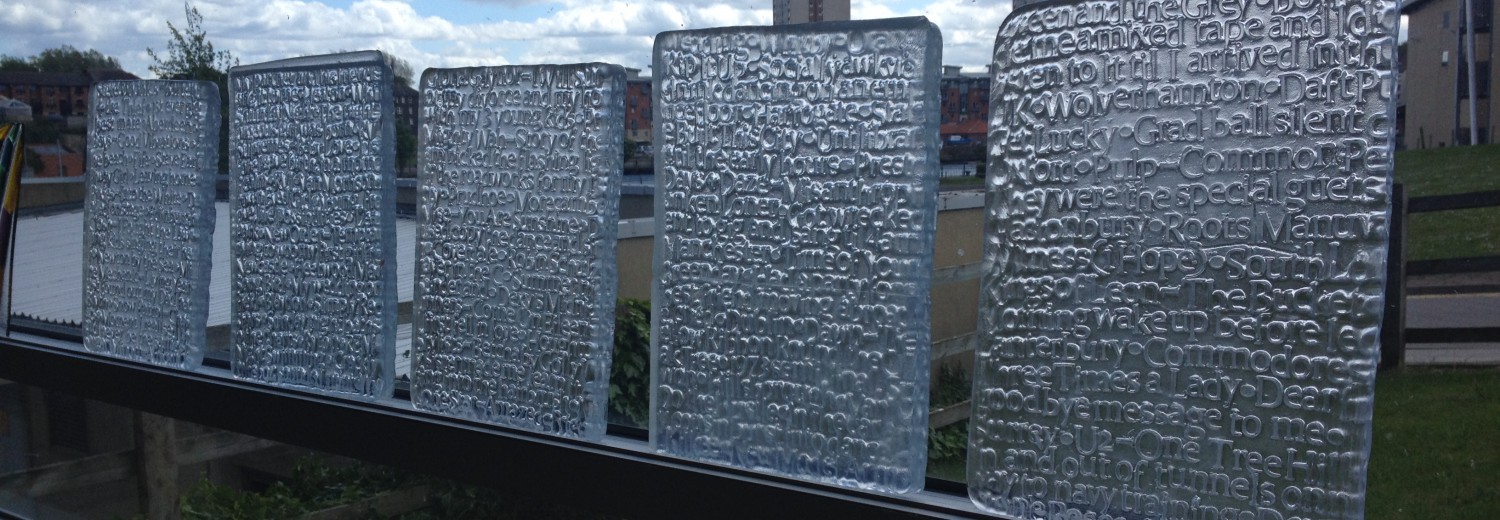Working from her home in Edinburgh, Keiko Mukaide explores techniques using glass as her main art medium. Although she considers her home to be in Scotland, Mukaide still has strong nostalgic links to her birthplace in Tokyo, from where she moved at a young age to study. Mukaide studied glass and ceramics at the Royal College of Art in London, when she first arrived in the UK, before her move to Edinburgh where she was a research fellow at the Edinburgh College of Art.
Keiko Mukaide’s work does not appear to have a distinctive style, allowing her to explore various areas of concept as well as experimenting with a wide range of materials. Much of her work is site specific as a result of gaining commissions, which ultimately affects the outcome.
Her love of glass as a material for making art comes from the joy she finds in working with light. Mukaide describes the actual feeling she experiences from the aesthetics of glass as it alters the light around you; “Glass is wonderful to achieve”.
Mukaide asks, “Does the place you live affect your work?”
Discussing her past works chronologically, Mukaide begins by relaying a trip to Lybster in 1996, where she was moved by the light flowing across the beach landscape, which inspired her to recreate the feeling she experienced.
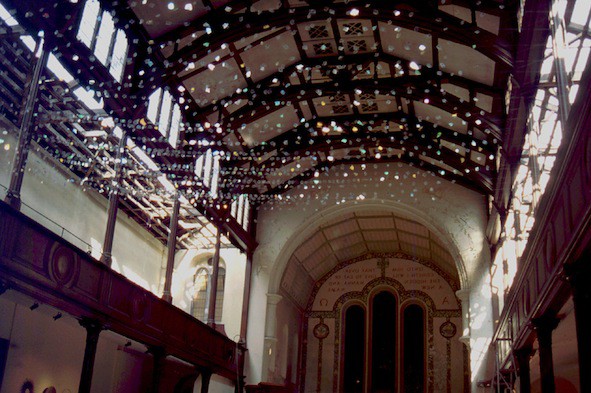
In response to this emotional connection to the light in the landscape by the Scottish sunshine, Mukaide created ‘Lucid in the Sky’ from dichroic glass. This piece was part of the Domain exhibition at the Fabrica Gallery in Brighton.
Keiko Mukaide has made an amazing living from public commissions and her interest in working with the assets of a site has seen some outstanding installation work. Since 2000, Mukaide has successfully created several site specific works, focussing on the history of the places and the flow of light and space. Those she discussed in relation to site specificity include:
Elemental Traces in Royal Botanic Garden, Edinburgh, 2000
Hydrosphere 2
Hydrosphere 3
Necurious Clouds Reflect Water
Miegakari, Hill House (Reflection from garden into house)
Curved Glass Walls (Inspired by Japanese paper screens)
Mist Trees (sound by John Cobban), 2002
Talbot Rice Gallery, Edinburgh (mapping of underground streams and energies of site)
By using influences from her Japanese heritage to inspire her projects, Keiko was able to put a part of herself into her works commissioned specifically for a place, leaving behind her artistic mark. In a busy gallery setting she was able to create a space for calm and reflection with her piece ‘Spirit of Place’ which she describes as a “positive energy vortex”. Pieces of spiralling, hanging, coloured glass allowing the viewer to literally reflect themselves and the light around them.
With her use of glass as a metaphor for the elusive forces of nature, Mukaide began working on a piece for Tate St Ives, in 2006. She explains how the site had a beautiful sea view of a Cornish beach, which inspired her to create a lighthouse based object. Using a lighthouse lens from Scotland (connecting to her adopted home), each of the twenty-four panels were set at an accurate point of longitude and latitude. This piece connected Mukaide herself to the site of the work and encouraged the viewer to encounter the landscape on a deeper level than just visually.
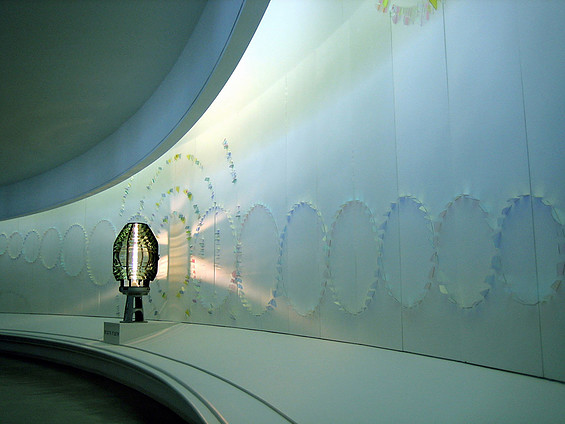
Mukaide went on to talk about how her personal life began affecting her practice after the death of her father in 2004. She spoke of how she hoped to transform her grief into a positive outcome, in terms of her creativity. After losing her father, whom she had left behind in Japan to pursue her career, Mukaide expressed her guilt of not spending more time with her family and her need to honour the life of her father through her work. Her commission for St Mary’s Church in York in 2007, allowed her to develop a site specific, interactive, honouring piece for her father.
The fountain bed, with flowing water from West to East, highlighted the distance between her birthplace and her current home and the distance between Mukaide herself and her family. Visitors were encouraged to release a candle into the water, watching it flow with the current in honour of a deceased loved one, to share their grief and to reflect. ‘Memory of Place’ was created with a glass pillar above it to represent the spirit and the journey to a higher level. The use of water in the artwork was intended to unite people together through their loss, as water is cleansing and purifying and seen through all religions often as a way of sharing.
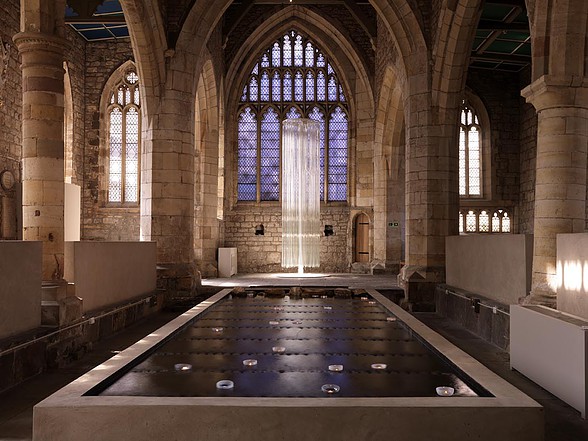
- Memory of Place (St Mary’s Church, York, 2007)
By connecting to her audience in her work, Mukaide discussed her desire to bring people together through their heritage after considering her own. At the Pittenweem Art Festival in Scotland, she was able to use the history of the fishing village to set up an installation to celebrate the past, present and future of the area. Placed in the Old Men’s Club in the town, Mukaide focussed on the inhabitants as her source of inspiration, exploring their trades and the projection of local people in resemblance to their ancestors. Her goal was to unite individuals as a community to explore their past and leave messages for the future.
Going back to her own heritage, Mukaide explained her distress when finding out about the devastating earthquake in Japan in 2010. As a way of reconnecting to her own country she began gathering information from survivors. ‘I have not heard from you, are you alright?’ was the installation based in a tent at the Pittenweem Art Festival, which brought her cultural heritage to the site. It included twelve stories from survivors of the tsunami, as well as postcards to appeal for help. The installation included water damaged photographs. As part of the grieving process for the loss of people and land, a campaign was set up to wash the images and clean the photos which would then be returned to their owners. Mukiade highlighted the comparison to the washing of a body and the significance of this after the death of a loved one.
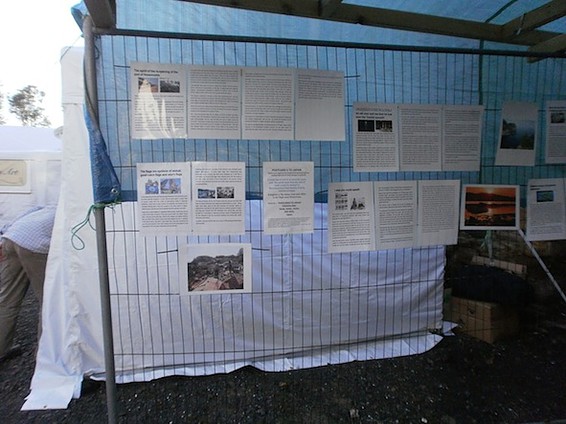
- ‘I Have Not Heard From You, Are You Alright?’ (Pittenweem Festival, 2011)
Mukaide’s personal connections to her work were much stronger than I originally anticipated. Her understanding of how individual experiences can alter your judgement in terms of your own artwork was fascinating. Culturally, her birthplace and her current home couldn’t be more different and yet her ability to consider how they have developed her as a person radiates from her work.
‘Thread Across the Sea’ created using Japanese to English dictionaries highlights the flexibility that Mukaide has in terms of artistic mediums. To explore the language of communication between cultures (ie Mukaide’s Japanese roots and her Scottish home), she creates this piece using 1500 orgami boats made in Scotland and 3000 orgami planes from Japan and displayed them as upcycled book art in the Scottish Fisheries Museum, connecting both of her homes.
Keiko was very forthcoming when discussing her private life and happily explained how important her family are to her. She talked about how she visits her mother regularly in Japan to take care of her now her father is gone and to re-experience traditions of her ancestors. Mukaide went on to talk of how cluttered her family home has become and how she insists on helping her mother make space. Yet her mother sees the possessions not as rubbish, but as memories.
The concepts she then began exploring were interesting, in regard to the loss of ownership of objects and how the memories fade away as people pass on with them. Mukaide used this idea to create a kimono shaped piece, from a dictionary. She explained how a kimono is traditionally passed down from mother to daughter, over generations and how this piece was symbolic for her own mother. Along with this was a stitched map, representing her mother’s destiny.
Keiko appears to be focussing more heavily on her heritage with her art and those who are the most important and influential in her life. She ended her presentation by stating that living in another country for a long time, makes you think about how you are different.
